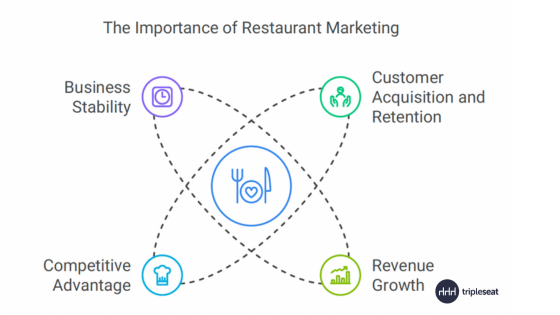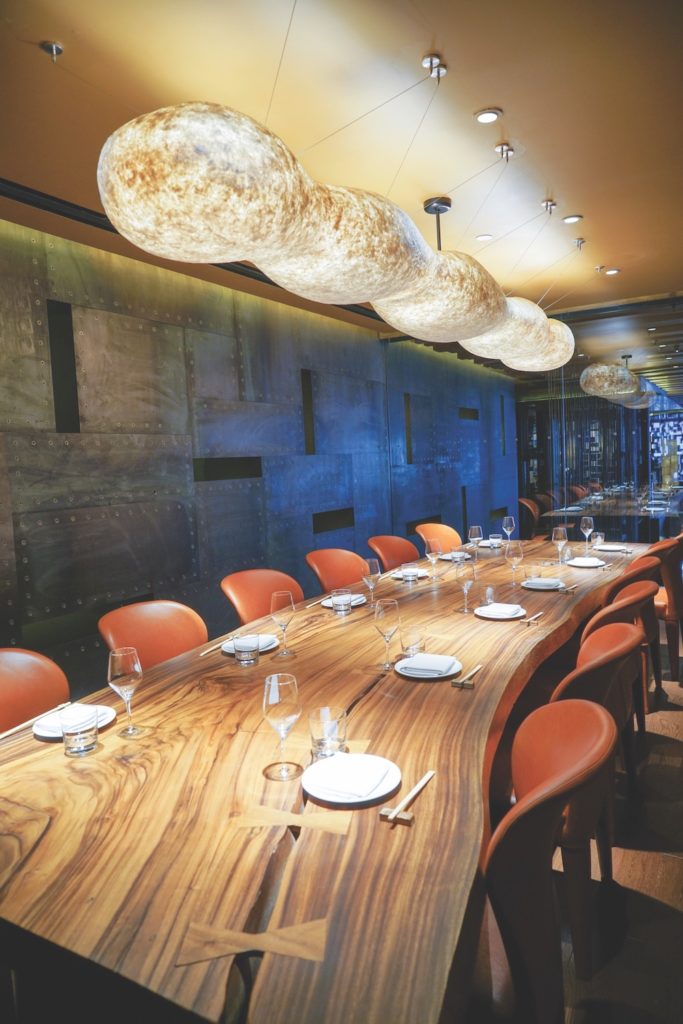Restaurant Marketing Tactics: Proven Strategies to Build Your Plan and Boost Business

Thinking about restaurant marketing? It might seem like a lot, but by focusing on some core principles, effective restaurant marketing tactics, and a clear restaurant marketing plan, you can really concentrate on the things that will bring you real success.
Here’s the thing: having a smart restaurant marketing plan with great restaurant marketing tactics can make a huge difference in your revenue. While positive reviews and word-of-mouth are fantastic, the current food landscape is pretty competitive, so taking a proactive and strategic approach is key to really shining.
We know how much hard work goes into running a restaurant. From perfecting your recipes to leading your team through busy times and managing costs, you’re doing amazing! That’s why we want to share our best restaurant marketing tactics to help you build a strong restaurant marketing plan that’s all about attracting new, eager customers. Whether you’re opening your doors for the first time or looking to bring a fresh energy to your existing restaurant, you might be asking yourself, “What’s the best way to bring more customers to my restaurant?”
What is Restaurant Marketing?
Restaurant marketing is the strategic process of attracting, engaging, and retaining customers for a restaurant to ultimately increase sales and build a strong brand reputation. It encompasses a wide range of activities designed to communicate the restaurant’s value proposition, menu, atmosphere, and overall dining experience to its target audience.

Why is Restaurant Marketing So Important?
Restaurant marketing is vital for success in today’s competitive dining industry for several critical reasons:
Improves Customer Acquisition and Retention
Let’s dive into something really exciting: how to bring in new faces and keep your regulars smiling! It’s all about the magic of attracting fresh customers while making sure the ones you already have feel like valued members of your restaurant family. Here is why marketing your restaurant can truly make a difference:
- Helps attract new customers in a crowded market
- Keeps existing customers engaged and returning
- Builds brand loyalty and recognition
Drives Revenue Growth
Let’s talk about the bottom line – the exciting part where all your efforts start turning into real success! Smart strategies can directly lead to your restaurant bringing in more revenue and achieving those growth goals you’ve been aiming for. These benefits can really make your business thrive:
- Drives awareness of special offers and promotions
- Increases average check size through upselling
- Creates additional revenue streams (catering, events, merchandise)
Provides a Competitive Advantage
It’s so important to find your unique spark and shine a little brighter than the rest. Here is why marketing your restaurant provides a valuable competitive advantage:
- Differentiates your restaurant from competitors
- Highlights unique selling points (specialty dishes, atmosphere, service)
- Keeps your restaurant top-of-mind for diners
Creates Business Stability
Ever dream of your restaurant being a reliable neighborhood staple, a place that consistently thrives no matter what? Smart restaurant marketing isn’t just about attracting a crowd today; it’s about laying the groundwork for long-term stability. Here’s why:
- Creates consistent customer demand
- Fosters customer loyalty and brand recognition
- Enables adaptability and resilience
- Supports sustainable growth

Steps to Take to Develop a Restaurant Marketing Plan: Your Roadmap to Success
Building a strong marketing strategy for your restaurant might seem daunting at first, but with a clear framework, you can confidently navigate the process. Think of this as your step-by-step guide to creating a solid and effective restaurant marketing plan:
1. Lay the Foundation: Research and Analysis
Know Your Crowd: Deeply understand your target market’s demographics, preferences, and dining habits. Why? This ensures your efforts reach the right people.
Scope Out the Competition: Analyze your competitors’ marketing strategies, their strengths, weaknesses, and how they position themselves in the market. Why? Identify opportunities to differentiate yourself.
Highlight Your Uniqueness: Clearly define your unique selling propositions (USPs) – what makes your restaurant special and better than the rest? Why? This is the core message you’ll communicate.
Set SMART Goals and Budget: Establish specific, measurable, achievable, relevant, and time-bound marketing objectives, and allocate a realistic budget. Why? This provides direction and keeps your efforts focused.
2. Craft Your Identity: Brand Development
Define Your Purpose: Create a concise and inspiring mission statement that articulates your restaurant’s core values and goals. Why? This provides a guiding principle for all your marketing.
Shape Your Voice and Look: Establish a consistent brand voice (personality and tone of your communication) and a compelling visual identity (logo, colors, fonts). Why? This creates a recognizable and memorable brand.
Tell Your Story: Develop an engaging brand narrative that connects with your audience on an emotional level. Why? People connect with stories, building stronger relationships.
Design Professional Assets: Create high-quality marketing materials (menus, website design, social media templates, etc.) that reflect your brand. Why? Professionalism builds trust and credibility.
Maintain Brand Consistency: Ensure your brand voice and visual identity are consistently applied across all your marketing channels, both online and offline. Why? Consistency strengthens brand recognition.
3. Master the Digital Realm: Digital Marketing Strategy
Engage Your Inbox: Develop a targeted email marketing program to nurture leads, announce promotions, and share valuable content. Why? Email marketing offers a direct line to your customers.
Build Your Online Hub: Create and optimize a user-friendly, mobile-responsive website that showcases your menu, location, hours, and allows for online reservations, ordering, and event information and booking. Why? Your website is often the first point of contact for potential customers.
Get Found Locally: Implement local SEO strategies to ensure your restaurant appears prominently in local search results (e.g., Google Maps). Why? Attract customers actively searching for restaurants in your area.
Plan Your Online Presence: Create a content calendar to strategically plan and schedule your social media posts and other website and online content. Why? Consistent and planned content keeps your audience engaged.
Harness the Power of Reviews: Actively monitor and engage with online reviews on platforms like Yelp, Google, and TripAdvisor. Why? Online reviews significantly influence customer decisions.
4. Shine on Social: Social Media Strategy
Choose Your Platforms Wisely: Establish a strong and active presence on the social media platforms where your target audience spends their time. Why? Focus your efforts where they’ll have the most impact.
Content is King (and Queen!): Regularly post high-quality, visually appealing photos and videos of your food, drinks, ambiance, and team. Why? Visual content is highly engaging on social media.
Offer Exclusive Peeks: Give your followers enticing behind-the-scenes glimpses into your kitchen, events, and daily operations. Why? This creates a sense of connection and exclusivity.
Stay on Trend: Keep an eye on current social media and food trends and consider incorporating them into your content strategy where relevant. Why? This helps you stay fresh and grab attention.
Maximize Discoverability: Utilize location tagging and relevant hashtags to reach a wider audience and connect with local searches. Why? Make it easy for people to find you.
5. Connect with Influencers: Influencer Partnerships
Identify Your Allies: Research and identify local food influencers (bloggers, social media personalities) whose audience and brand align with yours. Why? They can reach a highly targeted and engaged audience.
Create Win-Win Collaborations: Arrange complimentary tastings, invite them to special events, or offer exclusive experiences in exchange for content creation and reviews. Why? This provides valuable exposure and social proof.
Track Your Impact: Monitor the performance of your influencer partnerships (reach, engagement, website traffic). Why? Measure the effectiveness of your collaborations.
Build Lasting Relationships: Nurture ongoing relationships with key influencers to establish them as brand advocates. Why? Long-term partnerships can yield sustained benefits.
6. Create Buzz with Events: Event Marketing Strategy
Think Outside the Box: Plan and host unique, themed events and pop-up concepts that generate excitement and social sharing. Why? Special events create memorable experiences and attract new customers.
Offer Engaging Experiences: Organize interactive events like cooking classes, chef demonstrations, or wine/beer pairing dinners. Why? These events offer value beyond just dining.
Build Community with Regular Events: Establish consistent weekly events (trivia nights, live music, happy hour specials) to foster a loyal following and create a lively atmosphere. Why? Regular events provide a reason for customers to return frequently.
Amplify Your Reach: Explore partnerships with complementary local businesses for cross-promotional events to tap into new audiences. Why? Collaboration can expand your reach and impact.
7. Nurture Leads with Email: Email Marketing Tactics
Grow Your List Strategically: Implement various methods to build your email list, such as offering incentives for sign-ups on your website and in-store. Why? A strong email list is a valuable asset.
Segment for Success: Segment your email list based on customer preferences, purchase history, or engagement levels to send more targeted and personalized messages. Why? Personalized emails are more likely to be opened and acted upon.
Provide Real Value: Share exclusive content, special offers, early access to new menus, and invitations to events with your email subscribers. Why? Give them a reason to stay subscribed and engaged.
Track and Improve: Monitor key email marketing metrics like open rates, click-through rates, and conversion rates to understand what resonates with your audience and optimize your campaigns over time. Why? Data-driven decisions lead to better results.
8. Reward Loyalty: Loyalty Programs
Implement a Rewarding System: Establish a loyalty program that incentivizes repeat business through points, discounts, free items, or exclusive perks. Why? Rewarding loyalty encourages customers to choose you over competitors.
Offer Flexible Options: Consider both traditional punch cards (with a digital option for convenience) and integrated POS loyalty programs for seamless tracking and rewards. Why? Cater to different customer preferences.
Encourage Word-of-Mouth: Incorporate referral programs that reward both the referring customer and their referred friends. Why? Turn your loyal customers into brand advocates.
9. Become a Local Hub: Community Engagement
Get Involved: Actively participate in local food festivals, farmers’ markets, and community events to increase visibility and connect with your neighborhood. Why? Show your support for the community and reach potential customers.
Give Back: Support local charitable causes or community initiatives that align with your brand values. Why? This builds goodwill and strengthens your community ties.
Collaborate Locally: Seek out opportunities to partner with other nearby businesses for joint promotions or events. Why? Cross-promotion can expand your reach and benefit both businesses.
Build Relationships: Focus on building genuine relationships with other local businesses, organizations, and community members. Why? Strong local connections can lead to valuable partnerships and referrals.
10. Measure Your Impact: Measurement and Optimization
Identify Key Metrics: Determine the key performance indicators (KPIs) that will help you track the success of your marketing efforts (e.g., website traffic, social media engagement, customer acquisition cost, sales). Why? You can’t improve what you don’t measure.
Track Your ROI: Monitor the return on investment (ROI) of your various marketing activities to understand which strategies are delivering the best results. Why? Ensure your marketing spending is effective.
Listen to Your Customers: Actively gather and analyze customer feedback from online reviews, surveys, and in-person interactions. Why? Customer feedback provides valuable insights for improvement.
Utilize Tech: Leverage technology to track customer data, measure marketing effectiveness, and personalize outreach using tools like CRM systems, reservation platforms, event management software, and AI-driven analytics. Real-time reporting and automation help refine strategies, maximize ROI, and keep guests engaged in an increasingly competitive market.
Adapt and Evolve: Be prepared to analyze your data, identify what’s working and what’s not, and adjust your marketing strategies and tactics accordingly. Why? Continuous improvement is essential for long-term success.

Creative Ideas for Restaurant Marketing
Here are some creative ideas to inject life into your restaurant marketing efforts:
- Irresistible Online Offers: Entice first-time online bookers with a compelling offer, like a complimentary shared appetizer or a percentage off their first order.
- Strategic Retargeting: If potential customers visit your website but don’t make a reservation or order, use targeted ads to remind them of your restaurant’s appeal and encourage them to return.
- Visually Stunning Social Media: Consistently share high-quality photos and videos of your most appealing dishes, the restaurant’s ambiance, and behind-the-scenes glimpses to entice your followers.
- Trending Menu Twists: Keep your menu fresh and exciting by incorporating current food trends, such as creative remixes of classic dishes or visually impressive, shareable items like elaborately stacked milkshakes.
- Hyperlocal Social Media: Make sure to geo-tag all your social media posts with your restaurant’s location and use relevant local hashtags to connect with your community.
- Micro-Influencer Collaborations: Partner with local food bloggers and social media personalities who have a dedicated following within your target market. Offer them a complimentary meal in exchange for authentic reviews and engaging content.
- Interactive Events: Host unique and memorable events like dessert-focused pop-ups, intimate meet-the-chef evenings where guests can interact with your culinary team, or hands-on cooking classes. Think about promoted ticketed events to create a buzz.
- Community-Building Weekly Events: Establish regular weekly events, such as trivia nights, live music performances, or themed happy hours, to create a sense of community and encourage repeat visits.
- Enticing Email Opt-Ins: Offer a valuable incentive, like a discount on their next visit or a free appetizer, for customers who sign up for your email list.
- Modern Digital Loyalty: Move beyond traditional punch cards with user-friendly digital loyalty programs accessible through apps, making it easier for customers to track rewards and redeem offers.
- Gamified Loyalty: Introduce elements of gamification into your loyalty program, such as surprise rewards, bonus points for specific actions, or tiered membership levels with increasing benefits.
- Referral Rewards for Both: When a customer refers a friend who makes a purchase, reward both the referring customer and the new customer to incentivize participation in your referral program.
- Local Food Festival Presence: Set up a booth or participate in local food festivals to reach a wider audience and showcase your signature dishes.
- Community Support Initiatives: Partner with local charities or non-profit organizations for fundraising events or offer discounts to members of specific community groups to build goodwill.
- Cross-Promotions with Local Businesses: Collaborate with complementary businesses in your area (e.g., a local brewery, a nearby cinema) to offer joint promotions and reach each other’s customer bases.

Unlock New Revenue Streams: Marketing Your Restaurant’s Events and Private Dining
Beyond your regular dining service, your restaurant holds a wealth of untapped potential in the realm of events and private dining. These offerings not only provide significant revenue boosts but also offer unique opportunities to showcase your culinary expertise, ambiance, and exceptional service to a wider audience. Effective marketing is key to unlocking this potential and establishing your restaurant as the go-to destination for memorable gatherings.
Marketing to Event Planners & Businesses:
- Highlight Your Unique Event Spaces: Showcase any dedicated private dining rooms, semi-private areas, or even the possibility of a full restaurant buyout. Use high-quality photos and virtual tours on your website and marketing materials.
- Develop Tailored Event Packages: Create attractive and customizable packages for various event types (corporate meetings, holiday parties, weddings, workshops). Clearly outline menu options, beverage packages, AV capabilities, and any included services.
- Target Event Planner Networks: Reach out to local event planning companies, corporate event coordinators, and venue finders. Consider listing your space on relevant online platforms and directories, like EventUp.com, frequented by event professionals.
- Showcase Testimonials and Case Studies: On your website and in your marketing materials, feature glowing reviews from past event clients. Highlight successful events you’ve hosted, detailing the client’s needs and how your restaurant exceeded their expectations.
- Offer Special Incentives: Consider offering introductory discounts or referral bonuses to event planners who book with you.
- Create Dedicated Marketing Materials: Develop brochures, flyers, or a dedicated section on your website specifically outlining your event and private dining capabilities.
- Network Actively: Attend local business networking events and industry gatherings to connect with potential corporate clients and event planners.
Marketing to Individuals for Private Dining:
- Promote Intimate Celebrations: Target individuals looking for special venues to celebrate birthdays, anniversaries, engagements, and other milestones. Highlight the intimate and personalized experience your private dining options offer.
- Showcase Menu Flexibility: Emphasize your willingness to create custom menus to suit individual preferences and dietary needs.
- Create Visually Appealing Content: Use stunning photography or 2D or 3D visuals of your private dining spaces set up for various occasions on your social media channels and website.
- Run Targeted Social Media Campaigns: Utilize social media advertising to target individuals in your local area who are likely to be planning events or special occasions.
- Offer Seasonal or Themed Private Dining Menus: Create limited-time menus for holidays or special occasions that are specifically designed for private dining experiences.
- Encourage Online Inquiries and Bookings: Make it easy for individuals to inquire about private dining options through a dedicated form on your website or a direct contact method.
- Highlight the Ambiance and Experience: Go beyond just the food; emphasize the overall atmosphere, service, and unique experience your private dining offers.
General Marketing Strategies for Events & Private Dining
- Optimize Your Website: Ensure your website has a dedicated and easily accessible section for events and private dining, complete with clear information, pricing (or pricing guidelines), capacity details, and high-quality visuals.
- Leverage Social Media: Regularly post about your event capabilities, showcase past events, and run contests or promotions related to private dining. Use relevant hashtags to reach a wider audience.
- Utilize Email Marketing: Segment your email list to target subscribers who have expressed interest in events or private dining in the past. Send them tailored promotions and updates.
- Collaborate with Local Businesses: Partner with complementary businesses (e.g., florists, decorators, entertainment providers) to offer bundled event packages.
- Train Your Staff: Ensure your staff is knowledgeable about your event and private dining offerings and can confidently answer inquiries.
- Gather and Utilize Testimonials: Encourage clients who have hosted events or enjoyed private dining to leave reviews and testimonials that you can use in your marketing.
- Consider Virtual Tours: Offer virtual tours of your event spaces on your website to give potential clients a realistic view of what you offer.
- Track Your Results: Monitor inquiries, bookings, and revenue generated from your event and private dining marketing efforts to identify what’s working best and optimize your strategies accordingly.
By strategically marketing your restaurant’s event and private dining options, you can tap into a lucrative segment of the market, build stronger relationships with your community, and ultimately drive significant revenue growth for your business.
The bottom line? Get creative, embrace new channels, and never let your restaurant marketing efforts be an afterthought. There are hungry diners out there waiting to discover you – you just have to give them a darn good reason to find (and obsess over) your place.
Now go forth and market the heck out of that restaurant! A full, profitable reservation book will be your reward.
Check Out Tripleseat, a Powerhouse Event Management Platform
Are you ready to grow your event business? Schedule a Tripleseat demo to take a closer look at our event management features.
